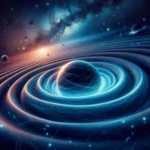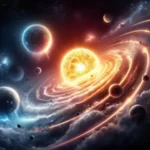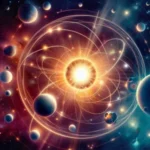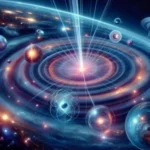Black holes have long captivated the imagination of scientists and the general public alike, embodying the ultimate enigma of our universe.
These cosmic vacuum cleaners, with their intense gravitational pull, seem to defy the laws of physics as we understand them. But how exactly do they form? In this blog post, we will embark on a journey through the intricate processes that lead to the birth of these mysterious entities, from the explosive deaths of massive stars in supernova events to the gradual accumulation of mass in dense regions of space. We’ll explore the fascinating theories and discoveries that have emerged from astrophysical research, shedding light on the life cycles of stars and the role of gravity in shaping the cosmos. Join us as we unravel the mystery of black holes, bridging the gap between complex scientific concepts and the wonder of the universe, to reveal the awe-inspiring phenomena that lie beyond our observable realm.
1. Introduction to Black Holes: What Are They?
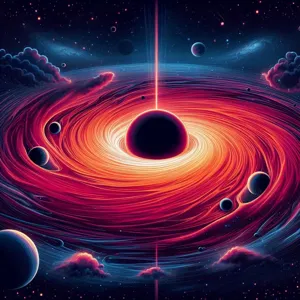
Black holes are among the most fascinating and enigmatic phenomena in the universe, captivating both scientists and the general public alike. At their core, black holes are regions of space where gravity is so intense that nothing, not even light, can escape their grasp. This extraordinary property gives them their name; they are “black” because they do not emit any light or radiation that our instruments can detect, making them invisible against the backdrop of the cosmos.
The formation of a black hole typically begins with the death of a massive star. During its lifetime, a star fuses hydrogen into helium in its core, producing energy that counterbalances the gravitational forces trying to collapse the star inward. However, once the star exhausts its nuclear fuel, it can no longer maintain this delicate balance. For massive stars, this leads to a dramatic and explosive end known as a supernova, an event that can outshine entire galaxies for a brief period.
As the star’s outer layers are expelled in this cataclysmic explosion, the core that remains may collapse under its own gravity. If the residual mass is sufficient—typically more than three times that of our Sun—the core will compress into an infinitely dense point known as a singularity, surrounded by an event horizon. The event horizon marks the boundary beyond which no information or matter can escape, rendering the black hole effectively invisible.
Black holes can vary in size, from stellar black holes formed from individual stars to supermassive black holes, which can contain millions or even billions of solar masses, often found at the centers of galaxies. As we delve deeper into the mysteries of black holes, we uncover not only the complexities of their formation but also the profound implications they hold for our understanding of physics, space, and the very fabric of the universe. In the following sections, we will explore the various types of black holes, the processes that lead to their formation, and the pivotal role they play in the cosmic landscape.
2. The Basics of Gravity and Its Role in Black Hole Formation
To understand how black holes form, we must first delve into the fundamental force that governs the movements of celestial bodies: gravity. Gravity is an invisible, yet immensely powerful force that attracts objects with mass toward one another. Sir Isaac Newton first described gravity in the 17th century, but it was Albert Einstein’s theory of general relativity in the early 20th century that deepened our understanding, illustrating gravity as the curvature of spacetime caused by mass.
At its core, gravity is responsible for the structure of the universe. It pulls stars, planets, and galaxies together, forming vast cosmic structures. In the lifecycle of a star, gravity plays a crucial role, especially in its end stages. When a massive star exhausts its nuclear fuel, the balance between the outward pressure from nuclear fusion and the inward pull of gravity begins to falter. As the star runs out of fuel, it can no longer support itself against its own gravitational collapse. This imbalance leads to a dramatic implosion, compressing the star’s core to an extraordinary density.
During this collapse, if the remaining mass is sufficient—generally more than three times that of our Sun—the core will continue to contract until it forms a singularity, a point of infinite density. Surrounding this singularity is the event horizon, the boundary beyond which nothing, not even light, can escape the gravitational pull. This marks the birth of a black hole.
Gravity, thus, is not just a force; it is the architect of black holes, shaping the very fabric of space and time, and creating these enigmatic entities that continue to intrigue and baffle scientists. Understanding gravity’s role is not only essential for grasping how black holes form but also for unraveling the greater mysteries of the universe itself.
3. Types of Black Holes: Stellar, Supermassive, and Primordial
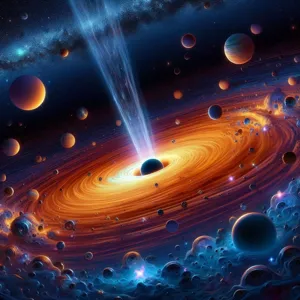
Black holes are not a one-size-fits-all phenomenon; they come in various types, each with unique formation processes and characteristics. Understanding these distinctions is crucial for grasping the broader tapestry of our universe. Here, we’ll explore the three main types of black holes: stellar, supermassive, and primordial.
**Stellar Black Holes** are the most commonly known variety, formed from the remnants of massive stars that have undergone a supernova explosion. When a star exhausts its nuclear fuel, gravity takes hold, collapsing the core under its own weight. If the remaining mass is around three times that of our sun or greater, it can create a stellar black hole. These cosmic entities typically range from about 3 to several tens of solar masses and are often detected by their gravitational influence on nearby stars and gas or through the X-ray emissions produced as they consume matter from companion stars.
**Supermassive Black Holes**, on the other hand, reside at the centers of most galaxies and possess masses ranging from millions to billions of solar masses. Their formation is still a subject of intense research and debate among astronomers. One prevailing theory suggests that they grew from the merging of smaller black holes and the accretion of vast amounts of gas and dust over billions of years. The supermassive black hole at the center of our Milky Way, known as Sagittarius A*, serves as a prime example of this type. Their immense gravity plays a critical role in shaping the structure and dynamics of galaxies, influencing star formation, and even affecting the trajectory of nearby stars.
Lastly, **Primordial Black Holes** represent a more speculative category, theorized to have formed in the very early universe, just moments after the Big Bang. These black holes could have originated from density fluctuations in the rapidly expanding cosmos. Unlike their stellar and supermassive counterparts, primordial black holes could range significantly in size, from very small—potentially even microscopic—to very large. While they remain largely hypothetical, their existence could help explain certain cosmic phenomena and dark matter, providing a fascinating glimpse into the universe’s infancy.
In summary, the universe presents a rich tapestry of black holes, from the remnants of colossal stars to the enigmatic giants that dominate galactic cores, and even those potentially born from the primordial chaos of the early universe. Each type offers profound insights into the lifecycle of stars, the evolution of galaxies, and the fundamental nature of reality itself.
4. The Life Cycle of Stars: From Birth to Collapse
The life cycle of stars is a breathtaking journey that unfolds over millions to billions of years, a cosmic saga marked by birth, evolution, and often, a spectacular end. This cycle begins in a nebula, a vast cloud of gas and dust, where gravity pulls together particles to form a protostar. As the protostar gathers mass, it heats up, and once it reaches a critical temperature, nuclear fusion ignites in its core, marking its transformation into a main-sequence star. This is the stage where stars like our Sun spend the majority of their lives, shining brightly as they convert hydrogen into helium.
As a star exhausts its hydrogen fuel, it enters a new phase characterized by dramatic changes. In larger stars, the core contracts under gravity, leading to increased pressure and temperature. This allows for the fusion of heavier elements, creating a more massive star that expands into a red giant. For smaller stars, like the Sun, this phase will culminate in shedding their outer layers, creating a beautiful planetary nebula, while the core remains as a white dwarf, gradually cooling over time.
However, for the most massive stars, the ending is far more cataclysmic. Once they have fused elements up to iron, they can no longer sustain the nuclear reactions that counterbalance gravitational collapse. When the core becomes too heavy, it collapses under its own weight in a catastrophic supernova explosion, blasting away the outer layers and leaving behind a remnant that may become a neutron star or, if the mass is sufficient, a black hole.
This transformation is not merely a transition from one stage to another; it is the culmination of stellar processes that recycle elements into the universe, seeding the formation of new stars, planets, and potentially life. Understanding the life cycle of stars not only illuminates the birth of black holes but also the profound interconnectedness of cosmic evolution, where the death of one star paves the way for the creation of another.
5. Supernova Explosions: The Birth of Stellar Black Holes
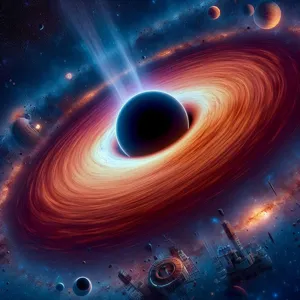
When it comes to the formation of stellar black holes, supernova explosions play a pivotal role in this cosmic drama. These cataclysmic events occur at the end of a massive star’s life cycle, marking both an awe-inspiring spectacle and a profound transformation. Picture a colossal star, much larger than our sun, burning fiercely in the vastness of space. For millions of years, it fuses hydrogen into helium, generating immense energy that counterbalances the gravitational forces pulling inward.
However, as the star exhausts its nuclear fuel, this delicate balance begins to falter. The core, unable to sustain its mass, collapses under the weight of gravity, leading to an implosion that sends shockwaves rippling outward. This is the moment when a supernova is born. The outer layers of the star are ejected into space with incredible force, creating a brilliant and colorful explosion that can outshine entire galaxies for a brief period.
What remains after this spectacular display is a dense core that has succumbed to its own gravity. If this remnant core exceeds a certain mass—typically around three times that of our sun—no known forces can stop the collapse, and it continues to compress into an infinitely small point known as a singularity. The surrounding region warps spacetime, creating what we recognize as a black hole.
These stellar black holes, formed from the remnants of dying stars, are not just intriguing cosmic phenomena; they are vital to our understanding of the universe. Their formation through supernova explosions highlights the cyclical nature of stellar evolution, where death gives rise to new cosmic entities. As we continue to explore the depths of space, these enigmatic structures serve as both a reminder of the violent forces at play in the universe and a beckoning mystery waiting to be unraveled.
6. The Role of Accretion Disks in Black Hole Formation
The formation of a black hole is a grand cosmic ballet, and at the heart of this dance lies the accretion disk—a swirling mass of gas and dust that plays a critical role in the birth of these enigmatic entities. Accretion disks form when a substantial amount of material begins to orbit a massive object, such as a collapsing star or a newly formed black hole. As this material spirals inward, it experiences intense gravitational forces that compress and heat it, creating a luminous disk that can outshine entire galaxies.
Within the accretion disk, friction and gravitational interactions generate immense temperatures, leading to the release of vast amounts of energy. This process not only illuminates the disk itself but also plays a pivotal role in the black hole’s growth. As the gases and debris spiral closer to the event horizon—the point of no return—they contribute their mass to the black hole, allowing it to increase in size and strength. The swirling motion of the disk also leads to angular momentum transfer, helping to maintain the stability of the disk while also facilitating the infall of material.
As the disk continues to feed the black hole, it can become incredibly dynamic, exhibiting powerful jets of radiation and particles that escape along the black hole’s rotational axis. These jets, which can extend for thousands of light-years into space, are a testament to the incredible energy and processes at play in the vicinity of a black hole, giving astronomers valuable insights into the mechanisms of black hole formation and evolution.
In summary, the accretion disk is not merely a backdrop to the formation of black holes; it is an active participant in their creation and growth. By feeding black holes with mass and energy, these disks create some of the most spectacular phenomena in the universe, helping to unravel the mysteries of how these fascinating cosmic giants come into existence.
7. The Formation of Supermassive Black Holes in Galaxies

The formation of supermassive black holes (SMBHs) is one of the most intriguing aspects of astrophysics, captivating scientists and stargazers alike. These colossal entities, often containing millions to billions of times the mass of our Sun, are typically found at the centers of galaxies, including our own Milky Way. Their origins are shrouded in mystery, but several theories attempt to unravel the complex processes that lead to their creation.
One prevailing theory suggests that supermassive black holes form through the merging of smaller black holes and the gradual accretion of surrounding gas and stars. In the early universe, when galaxies were still forming, dense regions of gas collapsed under their own gravity, creating the first generation of stars. As these stars lived and died, they left behind stellar black holes. Over billions of years, these smaller black holes could merge with one another, growing in mass and strength, eventually forming a supermassive black hole.
Another theory posits that supermassive black holes could arise from massive clouds of gas that collapse directly into a black hole without forming stars first. This process, known as direct collapse, could happen under specific conditions, such as in a high-density environment where primordial gas can rapidly condense. This rapid collapse creates a black hole much larger than the typical stellar variety, providing a potential seed for the growth of supermassive black holes.
Recent observations have revealed that SMBHs can also influence their host galaxies significantly. The gravitational pull of these black holes can affect the motion of stars and gas in their vicinity, creating a feedback loop that can regulate star formation within the galaxy. This interaction raises intriguing questions about the co-evolution of galaxies and their central black holes, suggesting that they are intertwined in a cosmic dance that has shaped the structure of the universe itself.
As researchers continue to study the dynamics of galaxies and the behavior of black holes, the formation of supermassive black holes remains a key area of investigation. New telescopes and advanced computational models are providing insights that could unlock more secrets about these enigmatic giants, helping us understand not only their origins but also their profound impact on the cosmos. The more we learn, the clearer it becomes that supermassive black holes are not merely cosmic oddities; they are fundamental players in the grand tapestry of the universe.
8. Theoretical Models of Black Hole Formation
Theoretical models of black hole formation have evolved significantly over the years, driven by advancements in our understanding of astrophysics and the universe’s fundamental laws. At the heart of these models lies the concept of gravity, a force so powerful that it can bend the very fabric of spacetime itself.
One of the most widely accepted theories is the **stellar evolution model**, which describes how massive stars undergo a lifecycle that ultimately leads to their collapse into black holes. When a star, typically more than three times the mass of our Sun, exhausts its nuclear fuel, it can no longer support itself against gravitational collapse. The outer layers of the star are expelled in a spectacular supernova explosion, while the core implodes, leading to a singularity—an infinitely dense point surrounded by an event horizon, beyond which nothing can escape the gravitational pull.
In addition to stellar collapse, researchers are also exploring the **direct collapse model**, which posits that certain gas clouds can collapse under their own gravity without forming stars first. In this scenario, massive gas clouds in the early universe might undergo rapid collapse due to their density, creating supermassive black holes almost instantaneously. This could explain the existence of supermassive black holes at the centers of galaxies, far larger than what conventional stellar evolution can account for.
Furthermore, the **merger model** is gaining traction, proposing that black holes can form through the merging of smaller black holes. As these remnants of massive stars orbit each other, they gradually lose energy through gravitational waves and spiral inward, ultimately coalescing into a larger black hole. Observations of gravitational waves from such mergers have provided crucial evidence supporting this model and have opened a new window into understanding the dynamics of black hole formation.
Each of these theoretical frameworks contributes to our understanding of black holes, but they also highlight the mysteries that remain. As astronomers continue to collect data and refine their models, the cosmic enigma of how black holes form may gradually unravel, revealing the intricate processes that govern the birth and evolution of these fascinating celestial objects. The interplay between theory and observation remains a dynamic field of study, driving scientists to probe deeper into the universe’s most elusive phenomena.
9. Black Holes and Dark Matter: Exploring Connections
Black holes and dark matter, two of the universe’s most enigmatic phenomena, are often discussed in tandem, yet their connection remains a subject of intense research and debate within the astrophysical community. Dark matter, which is believed to make up approximately 27% of the universe, does not interact with electromagnetic forces, making it invisible and detectable only through its gravitational effects. This mysterious substance plays a critical role in the structure and evolution of galaxies and, intriguingly, may also influence black hole formation.
One of the prevailing theories suggests that dark matter could be a catalyst for the creation of supermassive black holes found at the centers of galaxies. As dark matter clumps together under the influence of gravity, it can create dense regions that provide the necessary conditions for gas and dust to collapse, leading to the formation of stars and, subsequently, black holes. The gravitational pull of these nascent black holes can further attract surrounding dark matter, accelerating their growth and potentially resulting in the supermassive black holes we observe today.
Moreover, researchers are investigating whether interactions between dark matter and ordinary matter could lead to exotic phenomena, including the formation of primordial black holes in the early universe. These hypothetical black holes would have formed shortly after the Big Bang, driven by fluctuations in density within the dark matter field. If they exist, they could provide valuable insights into both the nature of dark matter and the early stages of cosmic evolution.
As scientists continue to probe the mysteries of black holes and dark matter, advancements in technology and observational techniques, such as gravitational wave detection and deep-space surveys, are poised to shed light on these connections. Understanding how these two cosmic entities interact not only enhances our knowledge of black holes but also deepens our comprehension of the universe’s fundamental structure, pushing the boundaries of what we know about the cosmos.
10. The Mystery of Primordial Black Holes
The Mystery of Primordial Black Holes
As we delve deeper into the enigmatic realm of black holes, we encounter an intriguing concept that has captivated astrophysicists and cosmologists alike: primordial black holes. Unlike their stellar counterparts, which form from the gravitational collapse of massive stars at the end of their life cycles, primordial black holes are theorized to have originated in the very early universe, mere moments after the Big Bang. This fascinating idea raises a multitude of questions about the nature of these ancient cosmic phenomena and their potential role in the evolution of the universe.
Primordial black holes are believed to have formed from density fluctuations in the extremely hot and dense environment of the early universe. As the cosmos expanded and cooled, regions of space with slightly higher density may have collapsed under their own gravity, creating black holes of various masses—ranging from tiny specks to hundreds of thousands of solar masses. This variance in size is particularly captivating, as it suggests a diverse population of black holes that could significantly differ from those formed from stellar deaths.
One of the most tantalizing aspects of primordial black holes is their potential connection to dark matter. Some scientists propose that these ancient black holes could constitute a portion of the elusive dark matter that makes up roughly 27% of the universe’s total mass-energy content. If true, primordial black holes could hold the key to unlocking some of the most profound mysteries of modern astrophysics, helping us understand not only the nature of dark matter but also the conditions that prevailed in the early universe.
While the existence of primordial black holes remains speculative, ongoing research and advanced observational techniques, such as gravitational wave detection and high-energy cosmic observations, may one day provide the evidence needed to confirm their presence. As we continue to unravel the mysteries surrounding black holes, the story of primordial black holes invites us to ponder the very fabric of our universe and the cosmic events that shaped its evolution. The quest to understand these enigmatic entities promises to deepen our comprehension of the cosmos and our place within it.
11. Observational Evidence: How Do We Know Black Holes Exist?
The existence of black holes, once relegated to the realm of theoretical physics, has gradually transitioned into a phenomenon supported by a wealth of observational evidence. But how do we know these enigmatic entities exist? The answer lies in a combination of indirect observations, advanced technologies, and profound theoretical understanding.
One of the most compelling pieces of evidence comes from observing the behavior of stars and gas clouds in the vicinity of seemingly empty regions of space. Astronomers have noted that some stars orbit around invisible objects, exhibiting rapid movements that suggest the presence of a massive gravitational force. For instance, in our own Milky Way galaxy, stars near the supermassive black hole at the center, known as Sagittarius A*, have been tracked as they dart around it at incredible speeds, hinting at a mass millions of times greater than that of our sun concentrated in a small area.
Moreover, the detection of X-rays emitted from accretion disks—rings of matter that spiral into black holes—serves as another vital piece of evidence. As matter accelerates and heats up while being pulled towards a black hole, it emits high-energy radiation detectable by telescopes. These X-ray emissions have been observed in various binary systems, where one star is a black hole consuming material from its companion star, further solidifying the case for their existence.
In April 2019, the Event Horizon Telescope made history by capturing the first-ever image of a black hole’s event horizon—an unmistakable shadow against the backdrop of glowing gas. This groundbreaking achievement provided the most direct visual evidence of black holes, validating decades of theoretical predictions. It was a monumental leap in our understanding and showcased the collaborative power of global scientific efforts.
In addition to these observations, the gravitational waves detected from colliding black holes, first observed in 2015 by the LIGO observatory, have opened a new frontier in astrophysics. These ripples in space-time serve as echoes of cataclysmic events that only black holes can produce, further confirming their existence in the cosmos.
Each layer of observational evidence adds to the intricate tapestry of understanding that surrounds black holes. While they may remain mysterious, the combined insights from astronomy, physics, and technology have revealed a compelling narrative: black holes are not just a figment of theoretical imagination but a real and vital component of our universe, challenging our understanding of gravity, space, and time.
12. The Impact of Black Holes on Their Surroundings
Black holes, once thought to exist only in the depths of the universe, have proved to be powerful players in the cosmic landscape. Their formation is just the beginning; the real intrigue lies in how these enigmatic entities influence their surroundings. The gravitational pull of a black hole is so immense that it can warp the fabric of spacetime, creating a profound impact on nearby stars, gas clouds, and even entire galaxies.
When matter approaches a black hole, it doesn’t just vanish; rather, it spirals inwards, forming what’s known as an accretion disk. This disk consists of gas and dust that heats up to extraordinary temperatures as it spirals closer to the event horizon, emitting X-rays and other forms of radiation in a spectacular display of energy. This process can illuminate the black hole, making it visible to astronomers and allowing them to study its effects on the surrounding environment.
Moreover, black holes can influence the orbits of nearby stars. Their immense gravitational field can cause stars to shift in their paths, leading to chaotic dance-like movements. In some cases, this gravitational influence can even lead to the ejection of stars from their original orbits, flinging them into the void of space—a phenomenon known as gravitational slingshot.
On a larger scale, supermassive black holes, located at the centers of galaxies, can regulate star formation within their host galaxies. As they consume material from their surroundings, they can heat the interstellar medium, preventing gas from cooling and collapsing into new stars. This feedback mechanism can have far-reaching consequences, shaping the evolution of galaxies over billions of years.
In summary, the impact of black holes on their surroundings is a complex interplay of gravitational forces, energy emissions, and galactic evolution. As researchers delve deeper into the mysteries of these cosmic giants, we uncover the undeniable reality that black holes are not just voids of nothingness; they are dynamic entities that play a crucial role in the universe’s grand tapestry.
13. Current Research and Future Discoveries in Black Hole Studies
As scientists continue to peel back the layers of the cosmos, current research on black holes is as dynamic and riveting as the phenomena themselves. The advent of advanced telescopes and observational technologies has ushered in a new era of astrophysical exploration. For instance, the Event Horizon Telescope (EHT), which famously captured the first-ever image of a black hole in 2019, is now paving the way for more detailed studies. Researchers are focusing on capturing higher-resolution images and analyzing the behavior of matter as it spirals into these enigmatic giants.
Moreover, gravitational wave astronomy has opened a new window into the universe. The LIGO and Virgo observatories have detected ripples in spacetime caused by the collision of black holes, providing unprecedented insights into their formation processes and population statistics. Each detection not only enhances our understanding of the size and frequency of black hole mergers but also tests the limits of our current theories of gravity and cosmic evolution.
Looking to the future, researchers are optimistic about the potential discoveries that lie ahead. The upcoming James Webb Space Telescope is expected to revolutionize our understanding of black holes in the early universe, shedding light on their formation and growth shortly after the Big Bang. Additionally, ongoing theoretical work aims to unravel the mysteries surrounding supermassive black holes at the centers of galaxies, exploring how they influence galactic formation and evolution.
As we push the boundaries of our knowledge, the quest to understand black holes is not just about these elusive entities themselves but also about what they reveal regarding the nature of space, time, and the universe as a whole. The journey of discovery continues, and with each new finding, we draw closer to unraveling the profound mysteries that black holes hold, making this an exhilarating time for astrophysicists and space enthusiasts alike.
14. Conclusion: The Ongoing Quest to Understand Black Holes
As we draw our exploration of black holes to a close, it’s clear that the quest to understand these enigmatic cosmic phenomena is far from over. Despite significant advancements in astrophysics and our growing arsenal of observational tools, black holes remain one of the universe’s most profound mysteries. They challenge our comprehension of physics, especially at the intersection of quantum mechanics and general relativity, and continue to provoke questions that spark curiosity across the scientific community and beyond.
The formation of black holes, whether through the catastrophic collapse of massive stars or the slow accumulation of matter in the dense centers of galaxies, offers tantalizing insights into the life cycles of cosmic entities. Each new discovery—from the first direct imaging of a black hole’s event horizon by the Event Horizon Telescope to the detection of gravitational waves from colliding black holes—serves as a reminder of the complexity of the universe and our place within it.
As we delve deeper into the cosmos, the pursuit of knowledge about black holes leads us to rethink fundamental aspects of reality, such as the nature of time, space, and gravity itself. With each new piece of data and every theoretical breakthrough, we inch closer to unraveling the intricate tapestry of black holes, yet they remain tantalizingly elusive. The ongoing quest to understand these celestial giants not only enriches our scientific landscape but also fuels our innate desire to explore the unknown, reminding us that in the vastness of the universe, there are still many mysteries waiting to be uncovered. As we look to the future, we can only speculate about what revelations lie ahead in this cosmic journey, but one thing is certain: the intrigue surrounding black holes will continue to captivate astronomers, physicists, and dreamers alike for years to come.
15. Further Reading and Resources on Black Holes and Cosmology
If you’re eager to delve deeper into the awe-inspiring world of black holes and the broader field of cosmology, a wealth of resources awaits you. Whether you’re a budding astronomer or simply a curious mind, the following books, documentaries, and online platforms will enrich your understanding and spark your imagination.
**Books**: Start with Stephen Hawking’s classic, *A Brief History of Time*, which offers a profound yet accessible overview of the universe, including black holes. For a more contemporary take, consider *Black Holes and Time Warps: Einstein’s Outrageous Legacy* by Kip Thorne, which explores both the science and the implications of black holes in our understanding of time and space. Meanwhile, *The Black Hole War* by Leonard Susskind provides an engaging narrative about the scientific debate surrounding black holes and the nature of information.
**Documentaries**: Visual learners will find documentaries such as *The Universe* series a fantastic resource. Episodes dedicated to black holes vividly illustrate these cosmic giants through stunning graphics and expert commentary. Additionally, Netflix’s *Black Hole Apocalypse* offers a breathtaking exploration of how black holes influence the cosmos, featuring interviews with leading astrophysicists.
**Online Platforms**: Websites like NASA’s official site and the European Southern Observatory provide a treasure trove of articles, images, and updates on current research. Furthermore, online courses from platforms like Coursera or edX can guide you through the fundamentals of astrophysics, often featuring lectures from renowned universities.
**Podcasts**: Tune into podcasts such as *StarTalk* hosted by Neil deGrasse Tyson, where intriguing discussions about black holes and other cosmic phenomena unfold, often bringing in elements of humor to make complex topics more relatable.
With these resources, you’ll not only expand your knowledge about how black holes form but also gain a deeper appreciation for the universe’s mysteries. Whether you read, watch, or listen, each medium offers a unique perspective that helps unravel the enigmatic nature of black holes and their significance in our universe. Happy exploring!
As we conclude our exploration into the enigmatic world of black holes, we hope this journey has illuminated the fascinating processes behind their formation and the profound implications they hold for our understanding of the universe. From the majestic collapse of massive stars to the intricate dance of matter in accretion disks, the birth of a black hole is a testament to the awe-inspiring forces at play in the cosmos. As we continue to unravel the mysteries of these celestial giants, we invite you to remain curious and engaged with the wonders of astrophysics. Whether you’re a seasoned space enthusiast or a newcomer to the subject, the quest for knowledge about black holes reminds us of the infinite possibilities that lie beyond our planet. Thank you for joining us on this cosmic journey, and we look forward to exploring more of the universe’s secrets with you in future posts!

